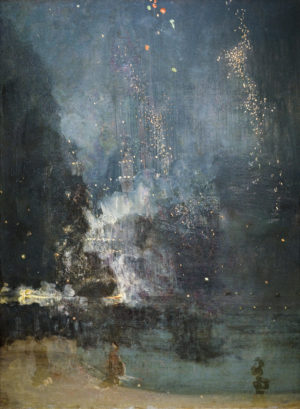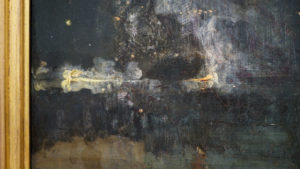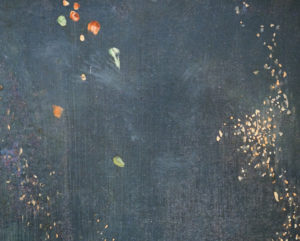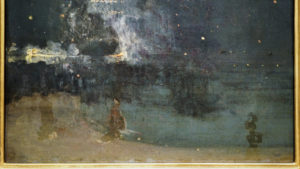James Abbott McNeill Whistler, Nocturne in Black and Gold, the Falling Rocket, 1875, oil on panel, 60.3 × 46.7 cm (Detroit Institute of Arts); a conversation with Dr. Steven Zucker and Dr. Beth Harris

James Abbott McNeill Whistler, Nocturne in Black and Gold: The Falling Rocket, 1875, oil on panel, 60.2 x 46.7 cm (Detroit Institute of the Arts; photo: Steven Zucker, CC BY-NC-SA 2.0)
A personal interpretation
One might say that for some artworks, seeing beyond the artist’s intention to form a more indefinite, personal interpretation is, ironically, the creator’s ultimate objective after all. Much like Alice stepping tentatively through the two-dimensional plane of the looking glass into the possibilities beyond, the viewer is invited to deduce his own meaning, to form his own associations, thus essentially taking part in the creative process itself. While ambiguity is standard in the conceptual contemporary pieces of today, what mattered most in early American art was what could be read on the surface: narrative clarity, illusionistic detail, realism, and straightforward moral instruction. When did things change? Perhaps, it seems, around the time avant-garde artists began to pursue abstraction, flirt with modernism, and challenge the aesthetic standards of the past.
Consider Nocturne in Black and Gold: The Falling Rocket of 1875. In the mass of shadowy dark hues, vague wandering figures, and splashes of brilliant color, museum-goers might construe myriad meanings from the same scene: perhaps sparks from a blazing campfire, flickering Japanese lanterns, or visions of far-off galaxies mystically appearing on a clear summer night. Indeed, while the Massachusetts-born artist James Abbott McNeill Whistler (1834-1903) was inspired by a specific event (a fireworks display over London’s Cremorne Gardens) the intangibility, both in appearance and theme, of the oil on panel was deliberate. The questions it conjures, the emotions it evokes, may differ from one viewer to another, and frankly, that’s the point.

Detail, James Abbott McNeill Whistler, Nocturne in Black and Gold: The Falling Rocket, 1875, oil on panel, 60.2 x 46.7 cm (Detroit Institute of the Arts; photo: Steven Zucker, CC BY-NC-SA 2.0)
“flinging a pot of paint in the public’s face”

Detail, James Abbott McNeill Whistler, Nocturne in Black and Gold: The Falling Rocket, 1875, oil on panel, 60.2 x 46.7 cm (Detroit Institute of the Arts; photo: Steven Zucker, CC BY-NC-SA 2.0)
The Falling Rocket resonates with many 21st-century beholders, yet when it was first exhibited at a London gallery in 1877, detractors deemed the painting too slapdash, incomprehensible, even insulting. Art critic John Ruskin dismissed Whistler’s effort as “flinging a pot of paint in the public’s face,” as in his opinion it contained no social value. In response, Whistler – cheeky man that he was – sued Ruskin for libel, and though he won the case in court, he was awarded only a farthing in damages. During the highly publicized trial, the artist defended his series of atmospheric “nocturnes” as artistic arrangements whose worth lay not in any imitative aspects but in their basis in transcendent ideals of harmony and beauty.
Music
Whistler saw his paintings as musical compositions illustrated visually, and delineated this idea is his famed “Ten O’Clock” lecture of 1885:
Nature contains the elements, in colour and form, of all pictures, as the keyboard contains the notes of all music. But the artist is born to pick and choose… that the result may be beautiful – as the musician gathers his notes, and forms his chords, until he brings forth from chaos glorious harmony.

Detail, James Abbott McNeill Whistler, Nocturne in Black and Gold: The Falling Rocket, 1875, oil on panel, 60.2 x 46.7 cm (Detroit Institute of the Arts; photo: Steven Zucker, CC BY-NC-SA 2.0)
Many of his titles incorporate allusions to music: “nocturnes,” “symphonies,” “arrangements,” and “harmonies.” The immaterial, the spiritual – these principles are subtly interwoven throughout Whistler’s oeuvre, and he preached his ideas on the new religion of art throughout his career.
Additional resources:
This painting at the Detroit Institute of Arts
Exhibition titled Whistler and His Followers at the Detroit Institute of Arts
Whistler Nocturnes at the Tate Britain
Smarthistory images for teaching and learning:
[flickr_tags user_id=”82032880@N00″ tags=”Falling Rocket,”]
[0:00] [music]
Dr. Steven Zucker: [0:04] We’re in the Detroit Institute of Art, looking at a painting by James McNeill Whistler called “Nocturne in Black and Gold, the Falling Rocket.” It was painted in 1875.
[0:17] He’s depicting a display of fireworks in the evening along the River Thames, but because it’s night, all form is obliterated; we can’t make out anything definite. It’s only the sparkle of the remnants of the rocket that had sent forth the fireworks that really catch our attention, and these are ephemeral.
Dr. Beth Harris: [0:35] The first thing to notice I think immediately is that the title doesn’t refer to some historical or mythological subject. It’s not a portrait or a genre scene. “Nocturne” is a term derived from musical compositions that evoke nighttime, that are inspired by the evening.
Dr. Zucker: [0:51] It’s interesting to think about what darkness and what nighttime meant in 1875.
[0:58] Although we take evening illumination for granted now — we just flip a switch and the lights come on — this is the moment when the cities become illuminated, when night is beaten back, when scientific advancement is encroaching on one of the most essential experiences of the human condition.
[1:15] It’s no surprise that Whistler and other artists are turning to the night as a subject.
Dr. Harris: [1:19] Imagine the typical exhibition-goer approaching this painting, expecting a narrative, a painting of figures or a landscape that was decipherable, with things that you could recognize. That told a story.
Dr. Zucker: [1:34] It is very modernist in that way. I think an important clue is, again, the title’s reference to music. In music, we don’t expect a narrative. We don’t need to have a story. It’s the notes and the rhythms and the texture of the music itself that can be enough to create beauty.
[1:50] It seems as if Whistler is asking the same kinds of questions. Can color, can tone, can their relationships be enough to create a profound emotional experience?
Dr. Harris: [2:00] The great art critic John Ruskin accused Whistler of “flinging a pot of paint in the public’s face.” Art was expected to show craftsmanship, to depict reality, to create illusions, to show the painter’s skill in creating those illusions.
[2:17] Whistler then took Ruskin to court. During the trial, Ruskin’s lawyer immediately got to the heart of the matter. He said to Whistler, “Did it take you much time to paint ‘Nocturne in Black and Gold?’”
[2:30] Whistler replied, “Oh, I knock one off possibly in a couple of days, one day to do the work and another to finish it.” Ruskin’s lawyer responds, “The labor of two days is that for which you ask 200 guineas?” Whistler replies, “No, I ask 200 guineas for the knowledge I have gained in the work of a lifetime.”
Dr. Zucker: [2:51] This speaks to the idea that the paintings are the product of a kind of philosophical inquiry. This is still an issue for us today in the 21st century. Where do we locate the value of a work of art? Is it in its craftsmanship? In the ability of the artist’s hand to render? Or is it in a set of ideas that are the foundation for the painting?
[3:12] We shouldn’t dismiss craftsmanship entirely. Whistler took great care in rendering this composition. He draws on important precedents, most specifically, Japanese printmaking. The Japanese artist, Hiroshige, specifically renders fireworks in the night sky. This rejection of narrative, of storytelling, is often referred to as “art for art’s sake.”
Dr. Harris: [3:34] This was something that was important to many artists in England beginning in the 1860s, especially artists like Albert Moore. Artists are looking to the formal qualities of art itself and reducing the importance of subject matter, of narrative.
[3:51] [music]

